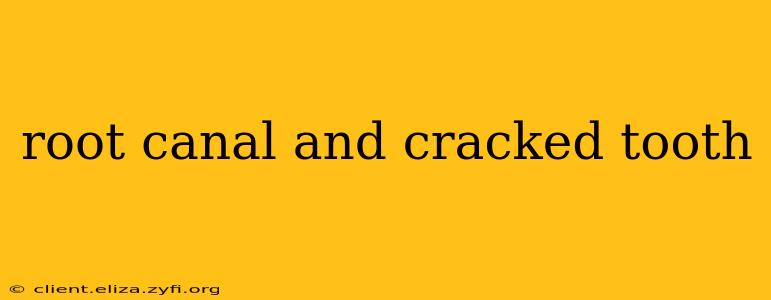A cracked tooth and the need for a root canal are often intertwined. While not always the case, a crack in a tooth can significantly increase the risk of needing a root canal. Understanding the relationship between these two dental issues is crucial for timely diagnosis and effective treatment. This comprehensive guide explores the connection, treatment options, and preventative measures.
What Happens When You Crack a Tooth?
A cracked tooth, also known as a fractured tooth, can range in severity. The crack might be a small, barely visible fissure, or it could extend deep into the tooth, reaching the pulp (the soft inner part containing nerves and blood vessels). The location of the crack also matters; cracks in the chewing surface (occlusal cracks) are often less problematic than those that extend down the root (vertical root fractures).
The immediate consequences might be minimal, with only mild sensitivity to temperature or pressure. However, as bacteria seep into the cracks, infection can develop, leading to significant pain, swelling, and the eventual death of the tooth's pulp. This is where a root canal becomes necessary.
Does a Cracked Tooth Always Need a Root Canal?
No, not all cracked teeth require root canals. Minor cracks, especially those confined to the enamel (the outer layer of the tooth), may not cause any serious problems and might only require monitoring or a simple filling to prevent further damage. However, if the crack reaches the dentin (the layer beneath the enamel) or the pulp, a root canal is often necessary to save the tooth. The dentist will determine the extent of the crack through a thorough examination, including X-rays.
How Can I Tell if I Need a Root Canal After a Cracked Tooth?
Several symptoms suggest the need for a root canal after experiencing a cracked tooth:
- Lingering or intense toothache: Pain that persists even after removing the irritant (e.g., hot or cold food) is a significant warning sign.
- Sensitivity to temperature changes: Extreme sensitivity to hot or cold, even after the stimulus is removed, indicates potential pulp involvement.
- Swelling around the tooth: Swelling and inflammation in the gums around the affected tooth suggest infection.
- Discoloration of the tooth: The tooth may darken or change color due to pulp death.
- Difficulty biting or chewing: Pain or discomfort while biting or chewing is another indicator of a serious problem.
If you experience any of these symptoms after cracking a tooth, seek immediate dental care.
What is the procedure for a root canal after a cracked tooth?
A root canal involves removing the infected or damaged pulp, cleaning and shaping the root canals, and filling them with a biocompatible material to seal them off. The tooth is then often protected with a crown to restore its strength and prevent further damage.
What are the alternatives to a root canal for a cracked tooth?
If the crack is too extensive or involves the root in a way that makes a root canal unsuccessful, extraction may be necessary. This would then be followed by restorative options such as a dental bridge or implant.
Can a cracked tooth heal itself?
Unfortunately, a cracked tooth will not heal itself. The crack provides an entry point for bacteria, and without intervention, the infection will likely worsen, ultimately leading to tooth loss.
How can I prevent a cracked tooth?
Prevention is key. Here are some tips:
- Avoid biting hard objects: This includes ice, hard candies, and pens.
- Wear a mouthguard: If you play contact sports or grind your teeth (bruxism), a mouthguard is essential.
- Maintain good oral hygiene: Regular brushing, flossing, and dental checkups are crucial for preventing dental problems.
In conclusion, a cracked tooth can lead to significant dental complications, and early diagnosis is crucial. If you suspect a cracked tooth, seek professional dental care promptly to assess the extent of the damage and determine the most appropriate treatment plan, which may or may not include a root canal. Remember, prevention is always the best approach to maintaining healthy teeth and gums.
